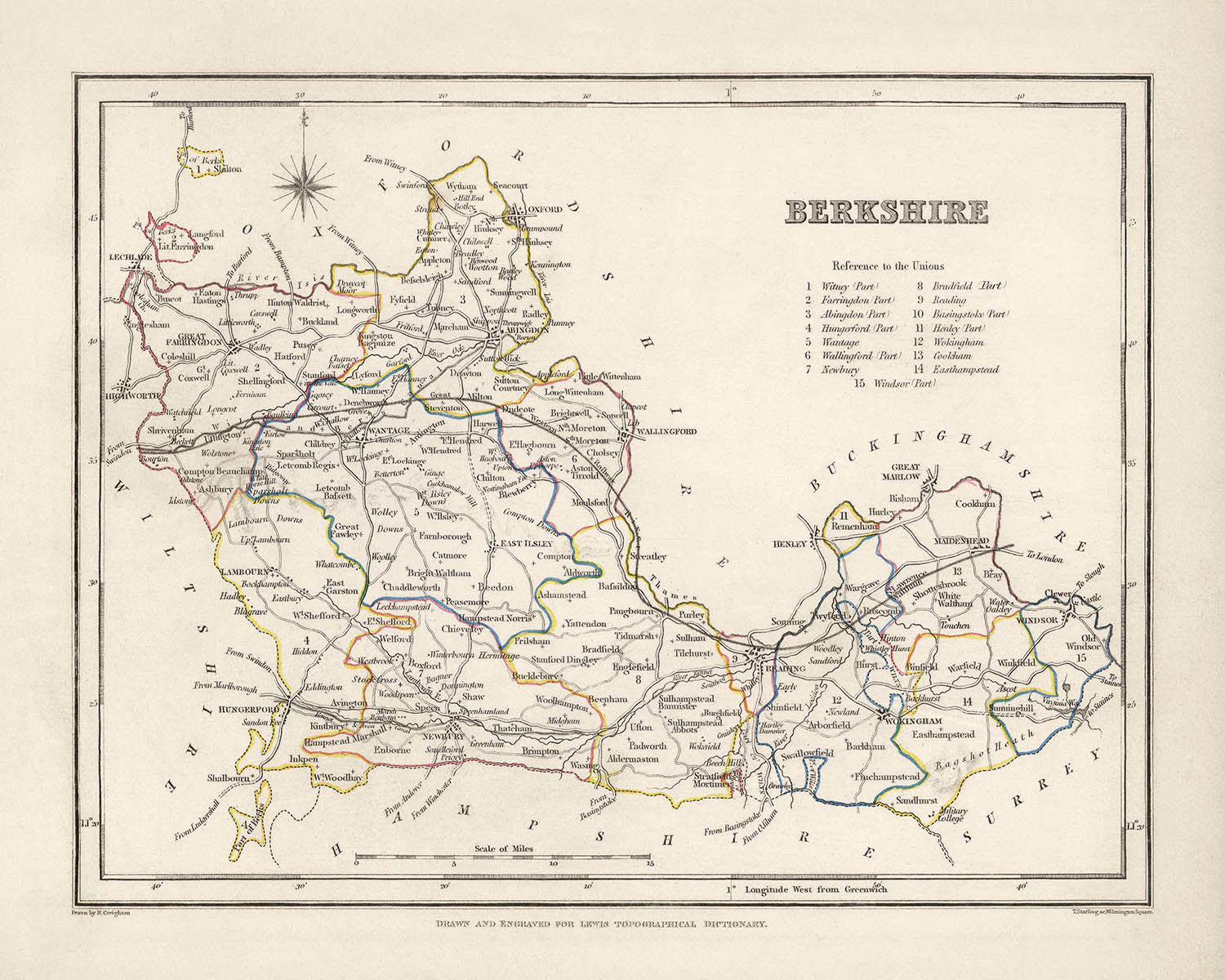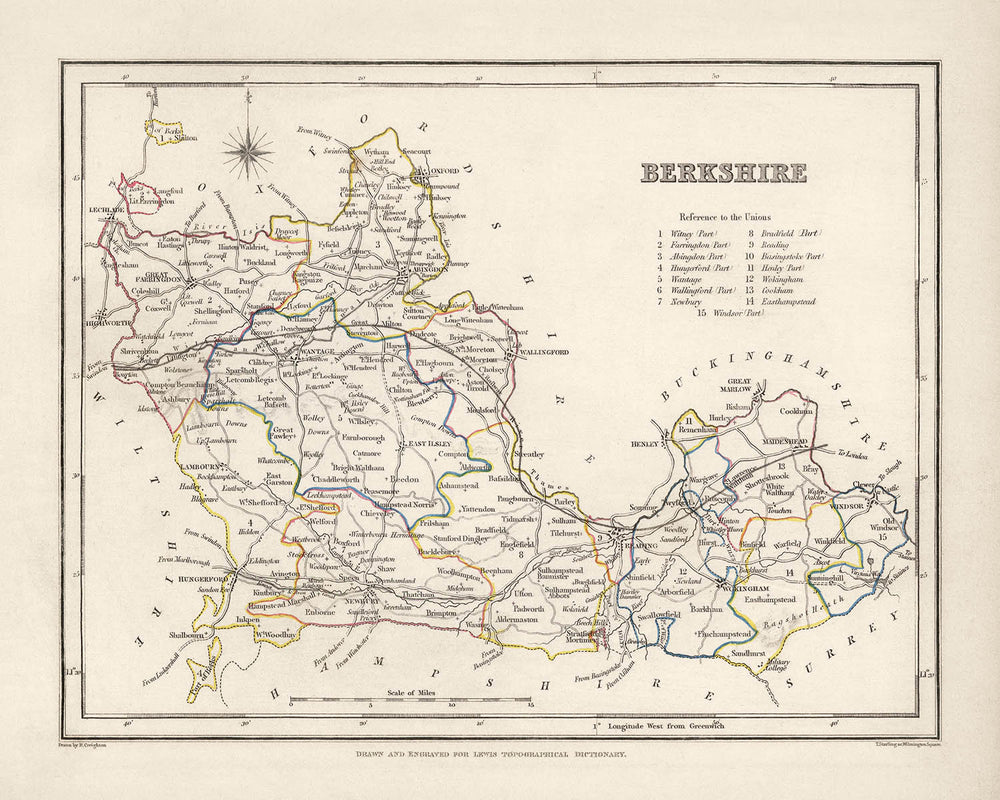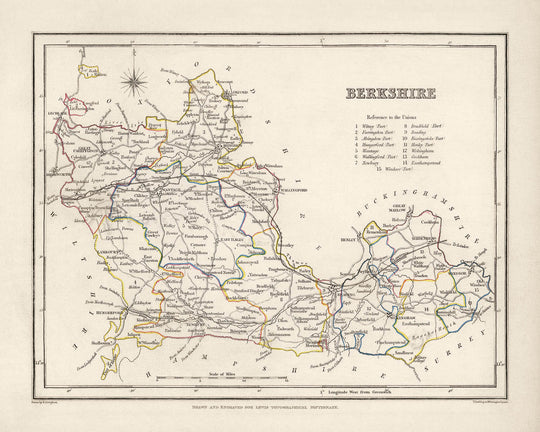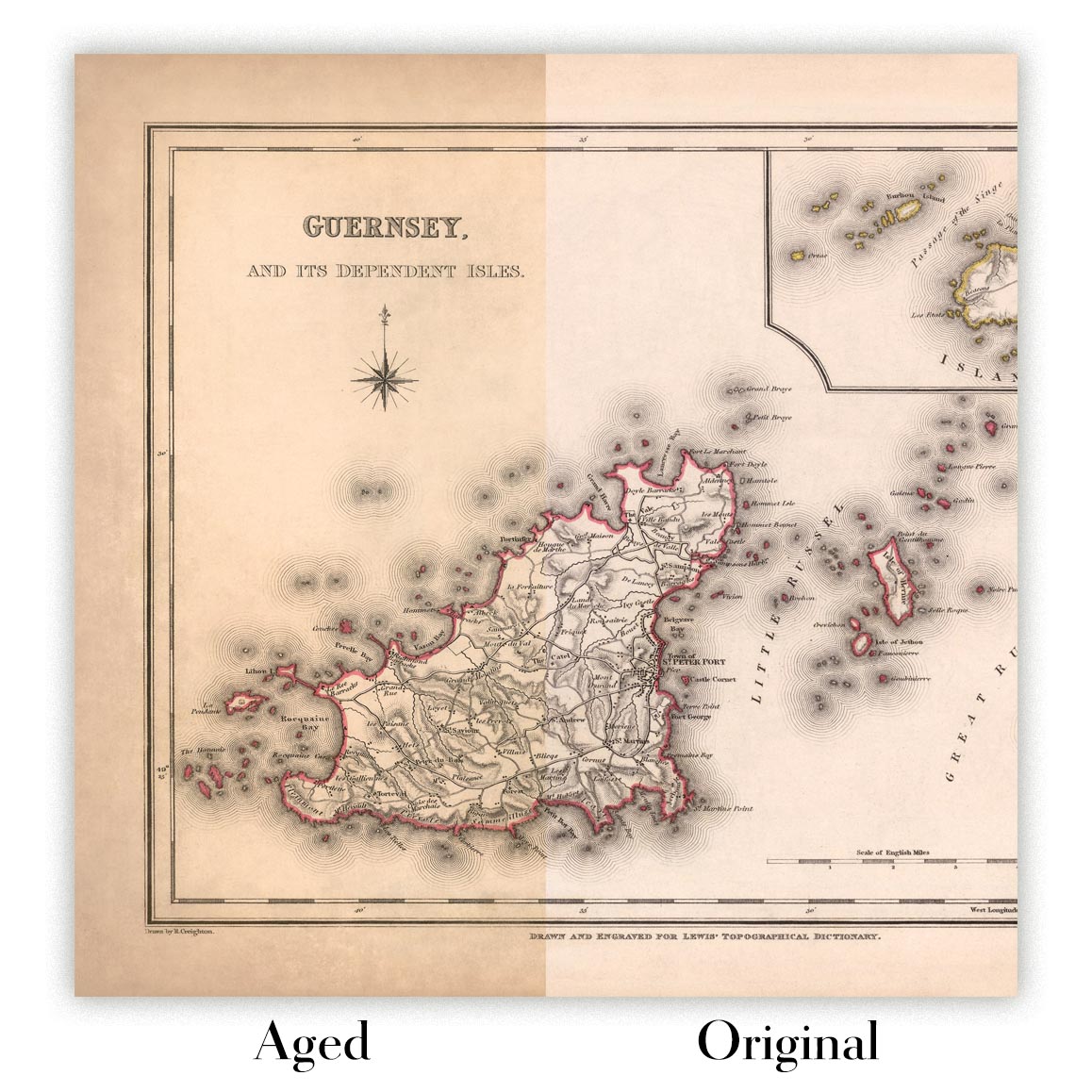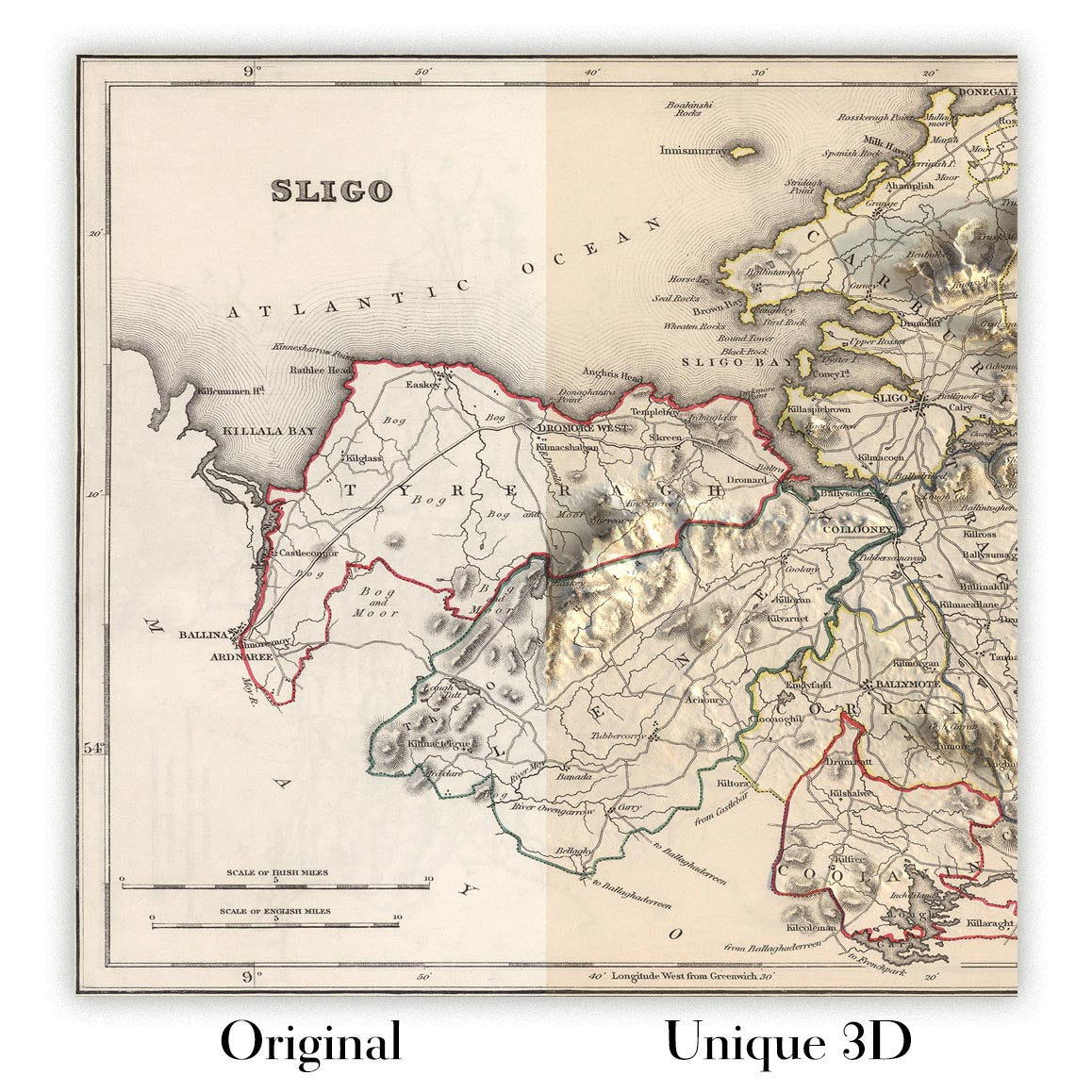- Handmade locally. No import duty or tax
- FREE worldwide delivery
- Love it or your money back (90 days)
- Questions? WhatsApp me any time
Own a piece of history
5,000+ 5 star reviews


This Old Map of Berkshire by Samuel Lewis in 1844 is a captivating piece that offers a glimpse into the historical landscape of the county. With its intricate details and exquisite cartography, this map serves as a window to the past, showcasing the towns, cities, and notable features that defined Berkshire during the mid-19th century.
While exploring this map, you will discover the prominent towns and cities of the time, including Reading, the county town and a bustling center of commerce; Windsor, home to the majestic Windsor Castle; Newbury, known for its historic market and racecourse; Abingdon, an ancient town with a rich medieval heritage; and Henley-on-Thames, renowned for its regatta and picturesque riverside setting. These vibrant locations, along with other interesting features depicted on the map, provide a captivating snapshot of Berkshire's historical significance.
It is important to note that some modern cities may not be present on this map, as it represents Berkshire as it existed in 1844. However, this adds to the allure of the map, as it allows you to witness the earlier names or absence of certain settlements that have since evolved or emerged over time. This captivating aspect makes the Old Map of Berkshire by Samuel Lewis a truly unique and valuable addition to any historical collection.
Notable settlements founded before 1840 within the historical boundaries of County of Berkshire, England:
- Reading (c. 871): A bustling town with a rich history, known for its abbey and later as a major center of the brewing industry.
- Windsor (c. 1070): Home to the iconic Windsor Castle, one of the official residences of the British monarchs.
- Newbury (c. 1079): An ancient market town with a vibrant history, famous for its cloth trade and horse racing heritage.
- Abingdon (c. 675): A town steeped in medieval history, known for its abbey and as a center of learning.
- Henley-on-Thames (c. 1179): A charming riverside town renowned for its regatta and picturesque setting.
- Wallingford (c. 900): An ancient market town with a rich history, once an important royal borough and river crossing point.
- Wantage (c. 849): Birthplace of King Alfred the Great and a town with deep historical roots.
- Thatcham (c. 913): A historic market town with connections to King Alfred the Great and the Kennet and Avon Canal.
- Wokingham (c. 1100): A market town with a long history, known for its timber-framed buildings and market square.
- Pangbourne (c. 862): A charming village situated on the River Thames, historically important for its river crossing.
- Lambourn (c. 1130): A picturesque village known for its horse racing heritage and scenic surroundings.
- Sonning (c. 7th century): A delightful riverside village with a long history, featuring a medieval bridge and picturesque setting.
- Cookham (c. 10th century): A tranquil village nestled on the banks of the River Thames, known for its natural beauty.
- Bucklebury (c. 10th century): A rural parish with a rich history, known for its association with the Middleton family.
- Compton (c. 6th century): A village with ancient origins, featuring a Saxon church and connections to King Alfred the Great.
- Stanford Dingley (c. 7th century): A charming village with a historic church and picturesque countryside.
- Kintbury (c. 7th century): A village with a long history, once an important center for the wool trade.
- Hurley (c. 11th century): A village steeped in history, featuring a medieval priory and picturesque riverside location.
- Inkpen (c. 7th century): A rural village with a rich history, known for its connections to the Domesday Book.
- Aldermaston (c. 7th century): A village with a fascinating past, featuring a historic manor and connections to the Atomic Weapons Establishment.
- Bradfield (c. 7th century): A picturesque village situated in an Area of Outstanding Natural Beauty, known for its historic church.
- Basildon (c. 7th century): A village with a long history, featuring a medieval church and connections to the Beale Park estate.
- Englefield (c. 7th century): A charming village known for its historic church and connections to the Englefield Estate.
- Burghfield (c. 7th century): A village with ancient origins, featuring a medieval church and connections to the Burghfield House estate.
- Mortimer (c. 7th century): A village steeped in history, known for its connections to the Mortimer family and Mortimer Common.
- Pangbourne (c. 862): A delightful village situated on the River Thames, historically important for its river crossing.
- Sulhamstead (c. 7th century): A rural village with a rich history, featuring a historic church and connections to Sulhamstead House.
- Streatley (c. 7th century): A picturesque village located on the banks of the River Thames, known for its stunning scenery.
- Theale (c. 7th century): A village with ancient origins, featuring a historic church and connections to Theale Abbey.
- Yattendon (c. 7th century): A charming village known for its historic church and connections to the Yattendon Estate.
- East Ilsley (c. 7th century): A rural village with a long history, known for its connections to the Ridgeway and horse racing.
Notable boundaries, rivers, and natural phenomena in County of Berkshire, England:
- River Thames: The iconic river that flows through Berkshire, offering picturesque views and recreational opportunities.
- Kennet and Avon Canal: A historic waterway that traverses the county, providing scenic walks and boating experiences.
- North Wessex Downs: A designated Area of Outstanding Natural Beauty, featuring rolling hills and charming villages.
- Windsor Great Park: A vast royal parkland known for its majestic deer herds and stunning landscapes.
- Chiltern Hills: A range of chalk hills extending into Berkshire, offering beautiful vistas and walking trails.
- Silchester Roman City Walls and Amphitheatre: The remains of a Roman town and amphitheater, providing insights into Roman Britain's history.
Historical events in County of Berkshire, England between 1800 and 1850:
- 1805: Battle of Trafalgar - Although not directly occurring in Berkshire, this naval battle off the coast of Spain had significant implications for the county and the nation.
- 1838: Opening of the Great Western Railway - The railway line connecting London to Bristol and passing through Berkshire was completed, revolutionizing transportation and trade.
- 1844: Publication of Samuel Lewis' Topographical Dictionary of England - Samuel Lewis, the cartographer of this map, published his renowned work providing detailed descriptions of towns and settlements across England, including Berkshire.
Please note that the information provided is based on historical records and may be subject to variations or updates based on further research.
Please double check the images to make sure that a specific town or place is shown on this map. You can also get in touch and ask us to check the map for you.
This map looks great at all sizes: 12x16in (30.5x41cm), 16x20in (40.5x51cm), 18x24in (45.5x61cm), 24x30in (61x76cm), 32x40in (81.5x102cm) and 40x50in (102x127cm), but it looks even better when printed large.
I can create beautiful, large prints of this map up to 50in (127cm). Please get in touch if you're looking for larger, customised or different framing options.
The model in the listing images is holding the 16x20in (40.5x51cm) version of this map.
The fifth listing image shows an example of my map personalisation service.
If you’re looking for something slightly different, check out my main collection of UK and Ireland maps.
Please contact me to check if a certain location, landmark or feature is shown on this map.
This would make a wonderful birthday, Christmas, Father's Day, work leaving, anniversary or housewarming gift for someone from the areas covered by this map.
This map is available as a giclée print on acid free archival matte paper, or you can buy it framed. The frame is a nice, simple black frame that suits most aesthetics. Please get in touch if you'd like a different frame colour or material. My frames are glazed with super-clear museum-grade acrylic (perspex/acrylite), which is significantly less reflective than glass, safer, and will always arrive in perfect condition.
This map is also available as a float framed canvas, sometimes known as a shadow gap framed canvas or canvas floater. The map is printed on artist's cotton canvas and then stretched over a handmade box frame. We then "float" the canvas inside a wooden frame, which is available in a range of colours (black, dark brown, oak, antique gold and white). This is a wonderful way to present a map without glazing in front. See some examples of float framed canvas maps and explore the differences between my different finishes.
For something truly unique, this map is also available in "Unique 3D", our trademarked process that dramatically transforms the map so that it has a wonderful sense of depth. We combine the original map with detailed topography and elevation data, so that mountains and the terrain really "pop". For more info and examples of 3D maps, check my Unique 3D page.
For most orders, delivery time is about 3 working days. Personalised and customised products take longer, as I have to do the personalisation and send it to you for approval, which usually takes 1 or 2 days.
Please note that very large framed orders usually take longer to make and deliver.
If you need your order to arrive by a certain date, please contact me before you order so that we can find the best way of making sure you get your order in time.
I print and frame maps and artwork in 23 countries around the world. This means your order will be made locally, which cuts down on delivery time and ensures that it won't be damaged during delivery. You'll never pay customs or import duty, and we'll put less CO2 into the air.
All of my maps and art prints are well packaged and sent in a rugged tube if unframed, or surrounded by foam if framed.
I try to send out all orders within 1 or 2 days of receiving your order, though some products (like face masks, mugs and tote bags) can take longer to make.
If you select Express Delivery at checkout your order we will prioritise your order and send it out by 1-day courier (Fedex, DHL, UPS, Parcelforce).
Next Day delivery is also available in some countries (US, UK, Singapore, UAE) but please try to order early in the day so that we can get it sent out on time.
My standard frame is a gallery style black ash hardwood frame. It is simple and quite modern looking. My standard frame is around 20mm (0.8in) wide.
I use super-clear acrylic (perspex/acrylite) for the frame glass. It's lighter and safer than glass - and it looks better, as the reflectivity is lower.
Six standard frame colours are available for free (black, dark brown, dark grey, oak, white and antique gold). Custom framing and mounting/matting is available if you're looking for something else.
Most maps, art and illustrations are also available as a framed canvas. We use matte (not shiny) cotton canvas, stretch it over a sustainably sourced box wood frame, and then 'float' the piece within a wood frame. The end result is quite beautiful, and there's no glazing to get in the way.
All frames are provided "ready to hang", with either a string or brackets on the back. Very large frames will have heavy duty hanging plates and/or a mounting baton. If you have any questions, please get in touch.
See some examples of my framed maps and framed canvas maps.
Alternatively, I can also supply old maps and artwork on canvas, foam board, cotton rag and other materials.
If you want to frame your map or artwork yourself, please read my size guide first.
My maps are extremely high quality reproductions of original maps.
I source original, rare maps from libraries, auction houses and private collections around the world, restore them at my London workshop, and then use specialist giclée inks and printers to create beautiful maps that look even better than the original.
My maps are printed on acid-free archival matte (not glossy) paper that feels very high quality and almost like card. In technical terms the paper weight/thickness is 10mil/200gsm. It's perfect for framing.
I print with Epson ultrachrome giclée UV fade resistant pigment inks - some of the best inks you can find.
I can also make maps on canvas, cotton rag and other exotic materials.
Learn more about The Unique Maps Co.
Map personalisation
If you're looking for the perfect anniversary or housewarming gift, I can personalise your map to make it truly unique. For example, I can add a short message, or highlight an important location, or add your family's coat of arms.
The options are almost infinite. Please see my map personalisation page for some wonderful examples of what's possible.
To order a personalised map, select "personalise your map" before adding it to your basket.
Get in touch if you're looking for more complex customisations and personalisations.
Map ageing
I have been asked hundreds of times over the years by customers if they could buy a map that looks even older.
Well, now you can, by selecting Aged before you add a map to your basket.
All the product photos you see on this page show the map in its Original form. This is what the map looks like today.
If you select Aged, I will age your map by hand, using a special and unique process developed through years of studying old maps, talking to researchers to understand the chemistry of aging paper, and of course... lots of practice!
If you're unsure, stick to the Original colour of the map. If you want something a bit darker and older looking, go for Aged.
If you are not happy with your order for any reason, contact me and I'll get it fixed ASAP, free of charge. Please see my returns and refund policy for more information.
I am very confident you will like your restored map or art print. I have been doing this since 1984. I'm a 5-star Etsy seller. I have sold tens of thousands of maps and art prints and have over 5,000 real 5-star reviews. My work has been featured in interior design magazines, on the BBC, and on the walls of dozens of 5-star hotels.
I use a unique process to restore maps and artwork that is massively time consuming and labour intensive. Hunting down the original maps and illustrations can take months. I use state of the art and eye-wateringly expensive technology to scan and restore them. As a result, I guarantee my maps and art prints are a cut above the rest. I stand by my products and will always make sure you're 100% happy with what you receive.
Almost all of my maps and art prints look amazing at large sizes (200cm, 6.5ft+) and I can frame and deliver them to you as well, via special oversized courier. Contact me to discuss your specific needs.
Or try searching for something!







